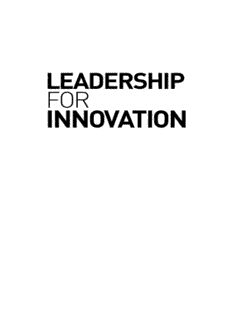
Leadership for Innovation: How to Organize Team Creativity and Harvest Ideas PDF
Preview Leadership for Innovation: How to Organize Team Creativity and Harvest Ideas
LEADERSHIP FOR INNOVATION LEADERSHIP FOR INNOVATION How to organize team creativity and harvest ideas JOHN ADAIR London and Philadelphia Publisher’s note Every possible effort has been made to ensure that the information contained in this book is accurate at the time of going to press, and the publishers and author cannot accept responsibility for any errors or omissions, however caused. No responsibility for loss or damage occasioned to any person acting, or refraining from action, as a result of the material in this publication can be accepted by the editor, the publisher or the author. First published in Great Britain in 1990 by the Talbot Adair Press as The Challenge of Innovation This edition published in Great Britain and the United States by Kogan Page Limited in 2007 as Leadership for Innovation Reprinted 2007 Apart from any fair dealing for the purposes of research or private study, or criticism or review, as permitted under the Copyright, Designs and Patents Act 1988, this publication may only be reproduced, stored or transmitted, in any form or by any means, with the prior permission in writing of the publishers, or in the case of repro- graphic reproduction in accordance with the terms and licences issued by the CLA. Enquiries concerning reproduction outside these terms should be sent to the publishers at the undermentioned addresses: 120 Pentonville Road 525 South 4th Street, #241 London N1 9JN Philadelphia PA 19147 United Kingdom USA www.kogan-page.co.uk © John Adair, 1990, 2007 The right of John Adair to be identified as the author of this work has been asserted by him in accordance with the Copyright, Designs and Patents Act 1988. ISBN-10 0 7494 4800 8 ISBN-13 978 0 7494 4800 4 British Library Cataloguing-in-Publication Data A CIP record for this book is available from the British Library. Library of Congress Cataloging-in-Publication Data Adair, John Eric, 1934- Leadership for Innovation : how to organise team creativity and harvest ideas / John Adair. p. c.m Rev. ed. of : The challenge of innovation. 1990. Includes index. ISBN-13: 978-0-7494-4800-4 ISBN-10: 0-7494-4800-8 1. Creative ability in business--Management--Case studies. 2. Technological innovations--Management--Case studies. I. Adair, John Eric, 1934- Challenges of innovation. II. Title. HD53.A32 2007 658.4’092--dc22 2006034629 Typeset by Jean Cussons Typesetting, Diss, Norfolk Printed and bound in Great Britain by MPG Books Ltd, Bodmin, Cornwall Contents About the Author ix Introduction 1 1. What is Innovation? 5 Invention and innovation 6 Case study: Google –the world’s most 7 powerful internet search engine Innovation as incremental change 8 The management of change 9 Innovation is positive 11 All can participate 12 Key Points 13 2. The Conditions for Successful Innovation 15 Management commitment 16 v Contents Positive strategic thinking 17 A long-term perspective 19 Responsiveness to change 21 Acceptance of risk 23 The right internal environment 25 Key Points 26 3. Organizing for Team Creativity 29 Order and freedom 30 Integrating creativity into industry 31 Getting the balance right 33 Leadership for innovation 35 Key Points 36 4. Case Study: The DNA Laboratory 39 No class or hierarchical differences 40 Leading by example 42 The optimum use of resources 43 The human resource 45 Creeping bureaucracy 45 Bureaucracy versus innovation 47 Key Points 49 5. Case Study: Soichiro Honda –Leader for 53 Innovation The forge of a creative mind 54 A creative thinker in action 55 A partnership of complementary abilities 56 Not problems but opportunities 57 Passing on the torch 59 Key Points 60 vi Contents 6. Real Commitment from the Top 63 The leader as teambuilder 64 Giving direction 66 Key Points 68 7. How to Motivate the Creative Individual 71 Selecting creative people 72 Characteristics of innovators 73 Expectations of creative people 76 Creative leadership 80 Key Points 82 8. Team Creativity 85 Building on ideas 86 Brainstorming 89 Team creativity in action 91 Team creativity and organization 93 How to criticize other people’s ideas 93 Key Points 97 9. Harvesting Ideas 99 Suggestion Schemes 100 Quality Circles 102 Success factors for Quality Circles 103 Towards team creativity 105 The importance of training and education 107 Key Points 108 vii Contents 10. Overcoming Resistance to Change 111 The human need for continuity and change 112 Understanding the forces of resistance 115 Principle one: plough up the ground 116 Principle two: market your ideas 118 Principle three: have a practice run 121 Principle four: make change incremental 122 Principle five: leadership is essential 123 Key Points 124 Conclusion: Leadership for Innovation 127 Key Points 131 Index 133 viii About the Author John Adair is now widely regarded as the world’s leading authority on leadership and leadership development. The author of 30 books on the subject, he has been named as one of the 40 people worldwide who have contributed most to the development of management thought and practice. Educated at St Paul’s School, John Adair has enjoyed a varied and colourful career. He served as adjutant in a Bedouin regi- ment in the Arab Legion, worked as a deckhand on an Arctic trawler and had a spell as an orderly in a hospital operating theatre. After Cambridge he became Senior Lecturer in Military History and Leadership Training Adviser at the Royal Military Academy, Sandhurst, before becoming the first Director of Studies at St George’s House in Windsor Castle and then Associate Director of the Industrial Society. Later he became the world’s first Professor in Leadership Studies at ix About the Author the University of Surrey. He also helped to found Europe’s first Centre for Leadership Studies at the University of Exeter. John Adair now acts as a national and international adviser on leadership development. His recent books, published by Kogan Page, include Not Bosses But Leaders, The Inspirational Leader, How to Grow Leadersand Leadership and Motivation. x
Description: